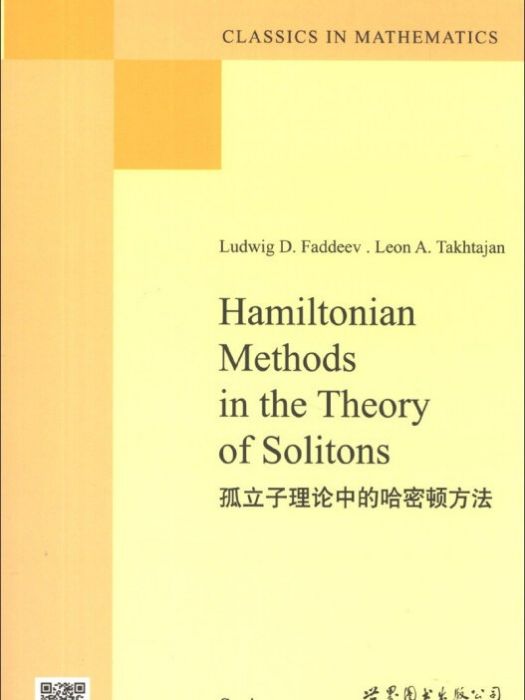《孤立子理論中的哈密頓方法》是2013年3月1日世界圖書出版公司出版的圖書,作者是L.D.法捷耶夫(LudwigD.Faddeev)。
基本介紹
- 中文名:孤立子理論中的哈密頓方法
- 作者:L.D.法捷耶夫(LudwigD.Faddeev)
- 出版社:世界圖書出版公司
- ISBN:9787510058264
內容簡介,圖書目錄,
內容簡介
The book is based on the Hamiltonian interpretation of the method, hence the title. Methods of differential geometry and Hamiitonian formalism in particular are very popular in modern mathematical physics. It is precisely the general Hamiltonian formalism that presents the inverse scattering method in its most elegant form. Moreover, the Hamiltonian formalism provides a link between classical and quantum mechanics. So the book is not only an introduction to the classical soliton theory but also the groundwork for the quantum theory of solitons, to be discussed in another volume.
The book is addressed to specialists in mathematical physics. This has determined the choice of material and the level of mathematical rigour. We hope that it will also be of interest to mathematicians of other specialities and to theoretical physicists as well. Still, being a mathematical treatise it does not contain applications of soliton theory to specific physical phenomena.
圖書目錄
Introduction References
Part One The Nonlinear Schrodinger Equation (NS Model)
Chapter Ⅰ Zero Curvature Representation
1.Formulation of the NS Model
2.Zero Curvature Condition
3.Properties of the Monodromy Matrix in the Quasi-Periodic Case
4.Local Integrals of the Motion
5.The Monodromy Matrix in the Rapidly Decreasing Case
6.Analytic Properties of Transition Coefficients
7.The Dynamics of Transition Coefficients
8.The Case of Finite Density.Jost Solutions
9.The Case of Finite Density.Transition Coefficients
10.The Case of Finite Density.Time Dynamics and Integrals of the Motion
1.Notes and References
References
Chapter Ⅱ The Riemann Problem
1.The Rapidly Decreasing Case.Formulation of the Riemann Problem
2.The Rapidly Decreasing Case.Analysis of the Riemann Problem
3.Application of the Inverse Scattering Problem to the NS Model
4.Relationship Between the Riemann Problem Method and the Gelfand-Levitan-Marchenko Integral Equations Formulation
5.The Rapidly Decreasing Case.Soliton Solutions
6.Solution of the Inverse Problem in the Case of Finite Density.The Riemann Problem Method
7.Solution of the Inverse Problem in the Case of Finite Density.The Gelfand-Levitan-Marchenko Formulation
8.Soliton Solutions in the Case of Finite Density
9.Notes and References References
Chapter Ⅲ The Hamiltonian Formulation
1.Fundamental Poisson Brackets and the /"-Matrix
2.Poisson Commutativity of the Motion Integrals in the Quasi-Periodic Case
3.Derivation of the Zero Curvature Representation from the Fundamental Poisson Brackets
4.Integrals of the Motion in the Rapidly Decreasing Case and in the Case of Finite Density
5.The A-Operator and a Hierarchy of Poisson Structures
6.Poisson Brackets of Transition Coefficients in the Rapidly Decreasing Case
7.Action-Angle Variables in the Rapidly Decreasing Case
8.Soliton Dynamics from the Hamiltonian Point of View
9.Complete Integrability in the Case of Finite Density
10.Notes and References
References
Part Two General Theory of Integrable Evolution Equations
Chapter Ⅰ Basic Examples and Their General Properties
1.Formulation of the Basic Continuous Models
2.Examples of Lattice Models
3.Zero Curvature Representation's a Method for Constructing Integrable Equations
4.Gauge Equivalence of the NS Model (#=-1) and the HM Model
5.Hamiltonian Formulation of the Chiral Field Equations and Related Models
6.The Riemann Problem as a Method for Constructing Solutions of Integrable Equations
7.A Scheme for Constructing the General Solution of the Zero Curvature Equation. Concluding Remarks on Integrable Equations
8.Notes and References
References
Chapter Ⅱ Fundamental Continuous Models
1.The Auxiliary Linear Problem for the HM Model
2.The Inverse Problem for the HM Model
3.Hamiltonian Formulation of the HM Model 4.The Auxiliary Linear Problem for the SG Model
5.The Inverse Problem for the SG Model
6.Hamiltonian Formulation of the SG Model
Chapter Ⅲ Fundamental Models on the Lattice
Chapter Ⅳ Lie-Algebraic Approach to the Classification and Analysis of Integrable Models Conclusion List of Symbols Index
……
Conclusion
List of Symbols
Index

